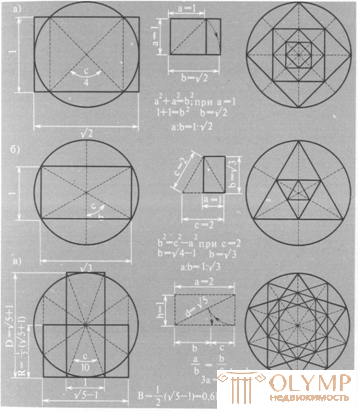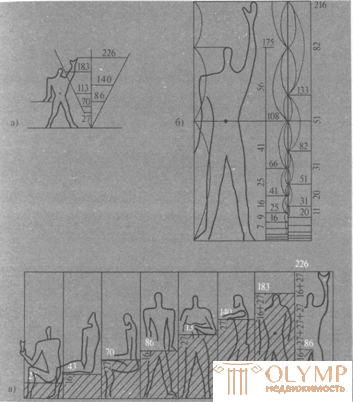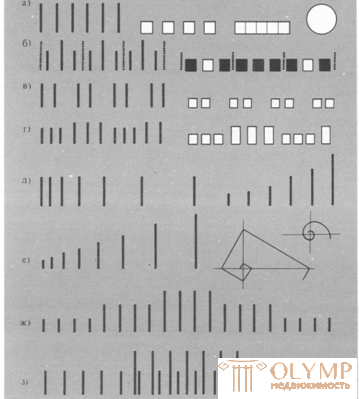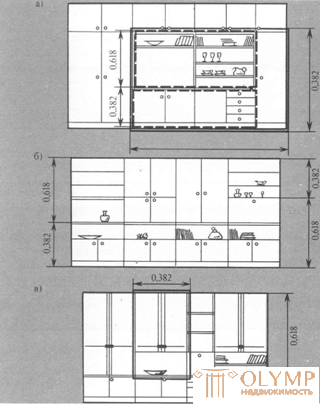
The most important means of solving modern furniture is the choice of its absolute and relative sizes. Choosing the size of furniture is one of the most difficult tasks and depends on a number of reasons. The dimensions of the furniture must ensure: ease of use, i.e., comply with anthropometry, the efficiency of the technological process and the requirements of mass production of furniture; should be linked to the space-planning parameters of the premises; must provide visual satisfaction with the appearance of the furniture product, which is based on the most important regularity of the composition - harmonization of form. The means of harmonization include proportions, scale, rhythm, contrast, nuance, etc. They help to reveal the main and subordinate in the composition, clearly show the rhythm of movement and the relationship of forms, establish a single proportionality of the parts and the whole.
The proportions (Fig. 1) express the quantitative interrelation of the parts and the whole, consisting (in the form of mathematical relationships) in the correctness of the geometric structure of the forms, in observing a single proportional measure of the structure of the individual parts and the whole. The proportion fastens and imparts the unity of the main characteristics that determine the harmony of forms: dimensional-spatial, linear-contour and color.

Fig. 1. The main types of proportional relationships
The most important section of the theory of composition is the study of the theoretical and practical problems of proportionate relations between man, equipment and the environment. The laws of anthropometry serve as the basis for the proportional and large-scale characteristics of the premises and their equipment with which a person comes into direct contact.
The laws of proportional communication due to visual perception. The compositional structure of the subject is a reflection of the laws of human visual perception. A good example of proportionality in modern architectural creativity can serve as a modulator Le Corbusier (Fig. 2). The modulator is a measurement tool that is based on the height of a person. A person with a raised hand gives us points defining the occupied space (leg, solar plexus, head, fingertip of the raised hand) - three intervals that determine the golden section series, called the Fibonacci series. On the other hand, mathematics offers some change here, very simple and at the same time very significant: a simple square, a doubling, and two golden sections.
On the Le Corbusier digital scale, the numbers and points plotted in proportion to human growth accurately determine the size of the space. All of them are clearly anthropometric. The ruler, created by the architect and built in accordance with the human body, indicates the main boundaries of the occupied space and is the simplest and most active factor in mathematical evolution, giving the unit of measurement values, its doubling and both golden sections, added or subtracted.
Combining the two positions in one picture, Le Corbusier received a very visual image. First, he identified the red series, the Fibonacci series, at around 108, and the blue series at 216 (doubling). Then he drew a human figure 1.75 m high, expressed in four figures: 0, 108, 175, 216. Finally, he placed the red ribbon on the left, blue on the right, the F series, tending to zero at the bottom, and to infinity at the top.

Fig. 2. Module Le Corbusier: a - modulator; b - the human figure is the basis of proportions; в - red number series subordinated to the relations of the golden section
The disadvantage was that, when summing up metric measures, it was impossible to express them in a foot-inch measurement. Therefore, the modulator sought to unify this disparity in the future in all countries. For this it was necessary to express the value of a foot-inch in integers. The scale of the new modulator, built on the basis of a person's height of 6 feet (6 feet-6X30.48 = 182.88 cm), was easily translated to whole-feet for whole inches at all levels.

Fig. 3. Types of rhythm: a - metric rows with intervals and without intervals; b - metric rows with alternating elements of two types; in - metric series with alternation of equal elements and equal intervals; d - metric series with alternation of unequal elements and unequal intervals; e - rhythmic rows of equal elements, repeating at increasing intervals, and rhythmic series with increasing elements at equal intervals; e - rhythmic series with increasing values of forms and intervals; g - rhythmic series formed by a combination of metric series; h - rhythmic series formed by the imposition of two metric series
The scale is a relative characteristic of the size of the object, due to the degree of dissection, the detail of the form. The formula of the scale is M = L-La, where M is a scale characteristic; L is the value of the product or parameter; L3 - the value of a similar product and the parameter of the usual normal scale, conventionally referred to as the reference object.
The feeling of scale is a subject-shaped perception of the world, of individual phenomena in their specific size and form. The scale gives the product a figurative characteristic, the form of membership, the modeling of the form. The concept of scale can be illustrated most clearly by the example of furniture products for children. Here the enlargement of parts, their generalization in the direction of reducing the number and definiteness of the form, as it were, corresponds to the regularity of the large-scale system of the child’s body. And, on the contrary, a certain size of the form, a considerable number of details create the impression of a larger furniture item.
A true idea of the scale is formed in a person in the process of everyday use of objects, the size of which is due to their function and requirements of operation. The scale of the product is considered large if the dimensions of its elements are larger than the usual, normal sizes of similar items. The scale looks small, if the parts are crushed, the shape of the product is unnecessarily dissected. For example, furniture and equipment of large halls should have an enlarged scale in comparison with furniture of small living rooms, saturated with a significant number of small objects and things, although in the other case the main dimensions of the products should be consistent with the anthropometry data.
A special group of means of harmonization consists of rhythmic and color combinations, a change in the surface texture, contrasting and nuanced combinations of sizes and shapes. Rhythm as a means of harmonization is closely related to the proportional and large-scale structure of the product. Rhythm is a uniform alternation of certain elements. It can be simple or complex (Fig. 3), contributes to clarity, clarity and symmetry of the composition, makes the artistic image more integral, complete, expressive, but it also becomes an essential means of emotional impact. Rhythmic composition occurs when the size or shape alternates at least 3 times.

Fig. 4. Examples of proportional proportions of modern cabinet furniture: a - a set of BN-109; b - set 6H-1300; in - set BN-153
Sometimes they introduce a different rhythm into one composition in order to highlight the main thing, to create a discharge for the eye. Accent is achieved not only by the interval, but also by the pattern inside the figure, color, etc. Different intervals of rhythmic movement can be decreasing, increasing, built on the principle of the golden section and other regularities. The most preferred in modern practice compositions based on repetitive elements.
A number of studies have established that such relationships as the golden section, the function of the golden section, geometrical and harmonic proportions are most often used. The study of modern practice allows us to note the prevailing distribution of modular systems, which are the basis of the design method of modern furniture.
Having defined the basic concepts associated with harmonization, we can illustrate them with specific examples of modern furniture solutions. In fig. 4 shows examples of proportional ratios of some samples of furniture. When designing, the functional purpose of the product and its compositional structure were taken into account.
Analysis of modern practice shows that to achieve favorable visual results obtained through the use of modular systems that ensure the rhythmic construction of individual furniture products and their sets, it is necessary to observe the laws of proportional construction of the form of furniture products.
Что бы оставить комментарий войдите
Комментарии (0)